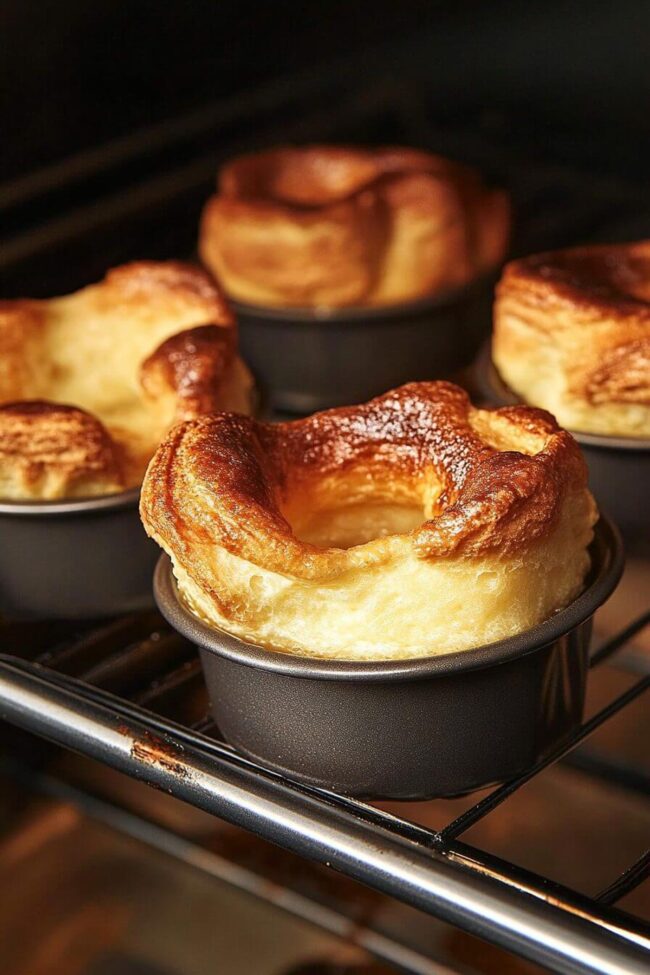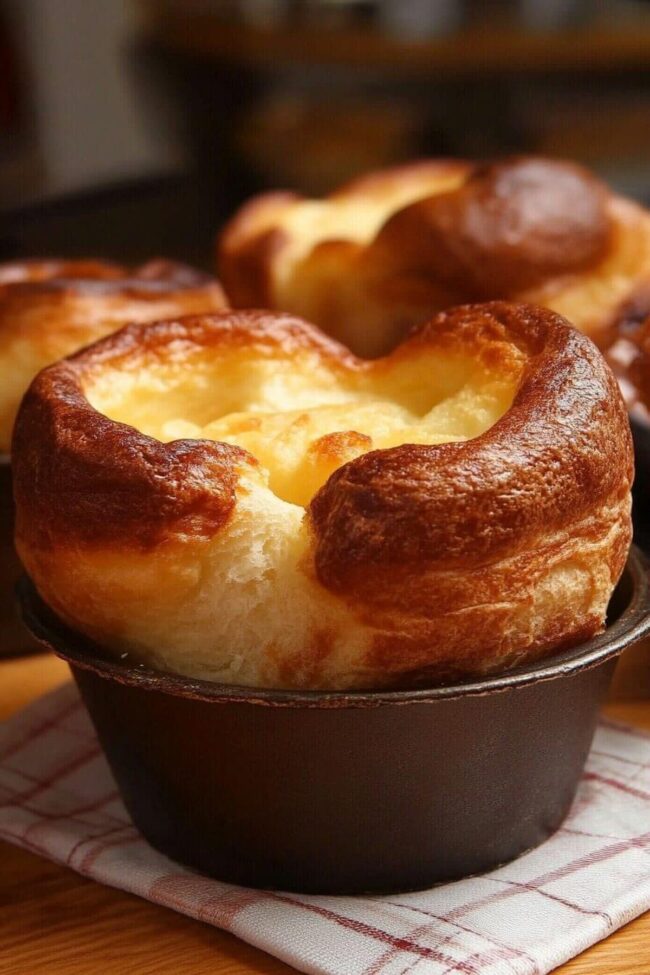Yorkshire Pudding Recipe with Crispy Finish
Yorkshire pudding sparks culinary curiosity with its magical rise and golden crispness.
Rich British traditions blend perfectly in this simple yet remarkable dish.
Crisp edges and tender centers create a delightful contrast that surprises many home cooks.
Light and airy textures promise a remarkable accompaniment to hearty meals.
Savory and versatile, this classic recipe connects generations through its humble ingredients and impressive presentation.
Passionate home chefs can easily master this technique with a few strategic tips.
You will feel like a skilled cook after creating these delectable puffs that complement roasted meats beautifully.
Explore this classic recipe and impress everyone at your next gathering.
Yorkshire Pudding: Golden, Puffy British Classic
Yorkshire Pudding Must-Have Ingredients
Flour and Batter Ingredients:Cooking Fat Ingredients:Serving Accompaniments:How to Make Yorkshire Pudding the Traditional Way
Step 1: Prepare Your Oven
Heat the oven to 425°F (220°C). Ensuring a scorching hot temperature is crucial for creating perfectly puffy Yorkshire puddings. The intense heat helps the batter rise dramatically and create crispy edges.
Step 2: Warm the Baking Vessel
Place a 12-cup muffin tin inside the heating oven. This preheating technique guarantees a crisp exterior and helps the puddings rise spectacularly. The hot pan is a secret weapon for achieving that signature golden-brown texture.
Step 3: Create the Silky Batter
Gather your ingredients:Whisk these ingredients together in a large mixing bowl until the mixture becomes incredibly smooth. Your goal is a liquid consistency similar to thin pancake batter with zero lumps. Mix thoroughly to incorporate air and ensure a light, airy result.
Step 4: Heat the Cooking Fat
Remove the scorching hot muffin tin from the oven with careful protection. Pour a small amount of oil into each cup:Return the tin to the oven for approximately 5 minutes. The fat should be sizzling and shimmering, ready to create magical crispy edges.
Step 5: Pour and Bake
Carefully extract the hot muffin tin. Fill each cup halfway with the prepared batter. The oil should be extremely hot when you pour the mixture, which helps create the dramatic rise.
Step 6: Bake to Perfection
Slide the tin back into the oven. Bake for 20-25 minutes until the puddings transform into golden, puffy clouds. Resist the temptation to open the oven door, as this might cause the delicate puddings to deflate.
Step 7: Serve and Enjoy
Remove the Yorkshire puddings immediately. These crispy, light treasures are best served piping hot alongside a traditional roast. Pair with:Drizzle with rich gravy for an authentic British dining experience.
Tips for Puffy, Golden Yorkshire Perfection
Storing and Reheating Yorkshire Pudding
Classic Dishes to Serve with Yorkshire Pudding
Twists on Yorkshire Pudding Worth Trying
Curious Cook’s Guide to Yorkshire Pudding FAQs
The high oven temperature of 425°F and preheated muffin tin are crucial. The hot oil and extreme heat cause the batter to quickly expand, creating that signature puffy texture.
While best served fresh and hot, you can prepare the batter in advance and keep it refrigerated for a few hours. Just whisk again before using and ensure your pan and oil are sizzling hot when ready to bake.
You can use a large baking dish or cast iron skillet instead. Just pour the entire batter into the hot, oiled pan and bake. The result will be one large, shareable Yorkshire pudding instead of individual portions.
Opening the oven door causes temperature fluctuations that can make the puddings collapse. The consistent high heat is essential for achieving the perfect rise and crispy exterior.
Print
Yorkshire Pudding Recipe
- Total Time: 35 minutes
- Yield: 4 1x
Description
Classic Yorkshire pudding elevates Sunday roast with British culinary charm. Golden, crispy edges and airy center invite you to savor a perfect accompaniment that connects generations of home cooks.
Ingredients
Main Ingredients:
- 3 large eggs
- 1 cup all-purpose flour
- 1 cup milk
Seasoning:
- ½ teaspoon salt
Cooking Fat:
- vegetable oil or beef drippings (as needed) for muffin cups
Instructions
- Prepare the oven by heating it to a high temperature of 425°F (220°C), ensuring a scorching environment crucial for achieving perfectly puffed Yorkshire puddings.
- Position a 12-cup muffin tin inside the heating oven, allowing the metal to become blisteringly hot and ready for baking.
- Create a silky-smooth batter by whisking flour, milk, eggs, and salt in a large mixing bowl until the mixture reaches a consistent, liquid-like texture with no visible lumps.
- Extract the searing-hot muffin tin and introduce a small pool of vegetable oil or beef drippings into each cup, then return the tin to the oven for an additional 5 minutes to superheat the fat.
- Carefully remove the tin from the oven and swiftly distribute the prepared batter into the sizzling oil, filling each compartment approximately halfway to allow ample rising space.
- Return the muffin tin to the oven and bake without interruption for 20-25 minutes, watching the puddings transform into golden, dramatically risen delicacies with crisp exterior edges.
- Immediately serve the piping-hot Yorkshire puddings alongside a traditional roast, complementing the meat with a generous drizzle of rich gravy for an authentic British culinary experience.
Notes
- High heat is crucial for achieving the signature puffed-up, crispy texture that makes Yorkshire puddings legendary.
- Preheating the muffin tin with oil ensures a dramatic rise and creates a golden, crunchy exterior.
- Whisk the batter thoroughly to eliminate lumps, creating a smooth consistency similar to thin pancake mix.
- Use fresh eggs and room temperature ingredients for the most consistent and impressive pudding results.
- Timing and temperature are critical; avoid opening the oven door during baking to prevent the puddings from deflating.
- Prep Time: 10 minutes
- Cook Time: 25 minutes
- Category: Dinner, Appetizer
- Method: Baking
- Cuisine: British
Nutrition
- Serving Size: 4
- Calories: 116
- Sugar: 1 g
- Sodium: 42 mg
- Fat: 5 g
- Saturated Fat: 1.5 g
- Unsaturated Fat: 3.5 g
- Trans Fat: 0 g
- Carbohydrates: 14 g
- Fiber: 0.5 g
- Protein: 4 g
- Cholesterol: 43 mg









Isabella Rossi
Founder & Culinary Content Creator
Expertise
Recipe Development, Traditional Irish and European Cuisines, Food Styling and Photography, Culinary Education
Education
Dublin Institute of Technology (DIT) – School of Culinary Arts and Food Technology
Ballymaloe Cookery School
Liam is the voice behind many of Craft Meats’ most flavorful features. With roots in Dublin’s smoky barbecue scene and a culinary degree from the Dublin Institute of Technology, he brings time-tested cooking techniques to life.
His training at Ballymaloe Cookery School sharpened his farm-to-table approach, giving him a deep respect for every ingredient he writes about.
He’s not about overcomplicating the process, just helping you cook meat that’s worth talking about. When he’s not writing or grilling, he’s out foraging or nerding out on regional spice blends to add to his next recipe.